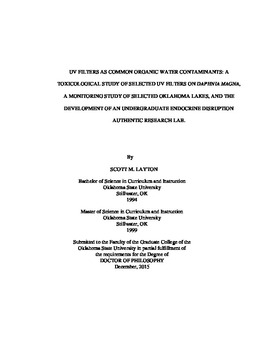| dc.description.abstract | UV filters are added to a number of personal care products to mitigate damage to underlying surfaces and several studies have identified their presence of in a variety of water compartments in the environment. UV filters have demonstrated endocrine disrupting potential in vertebrate models, but few studies have addressed their effects on resident aquatic invertebrates. The acute and chronic effects of the UV filters avobenzone, dioxybenzone, homosalate, octyl methoxycinnamate, octisalate, and oxybenzone on Daphnia magna were assessed. Only avobenzone was acutely toxicity at LC50 0.74 (0.41, 0.94) mg/L. Chronic effects of inhibited reproductive occurred in the upper test concentrations for all UV filters. A potential hormetic effect on reproduction was noted in dioxybenzone, homoslate, octisalate, and oxybenzone (LOEC 0.75, 0.075, 0.0019, 0.7 mg/L). Male neonates, a potential indication of endocrine disruption, were identified in avobenzone, homosalate, and oxybenzone tests (LOEC 0.004, 0.6, and 5 mg/L). Environmental monitoring of UV filters is limited, especially in high use recreational lake areas. The current work identified the presence octisalate, homosalate, oxybenzone, and OMCN in selected US lakes using GC/MS. A seasonal (July-October) and spatial(beach versus offsite) effect on UV filter concentration was noted for the detected UV filters, but only octisalte, homosalate, and oxybenzone were found to be significant. Hazard quotients (HQ) were calculated using the maximum environmental concentration from this study and LOEC from our toxicological study and previous studies. HQ's for detected UV filter were well below 1, indicating the tested UV filters are not likely occurring in concentrations high enough to produce toxicological effects. Many anthropogenic compounds such as pharmaceuticals and insecticides have demonstrated potential for endocrine disruption. Despite this knowledge, teaching this concept in undergraduate labs is not common most likely due to complexity, expense, and difficulty in observation. A research system using the invertebrate D. magna and the pesticide fenoxycarb is presented that demonstrates endocrine disruption, alleviates the complications of vertebrate models, and engages students in an authentic research experience. The system has been implemented in a small class containing a variety of declared major with 90% of the students showing proficiency in procedures and conceptual knowledge. | |
